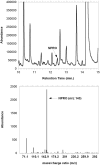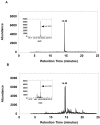A gas chromatography-mass spectrometry method for the quantitation of N-nitrosoproline and N-acetyl-S-allylcysteine in human urine: application to a study of the effects of garlic consumption on nitrosation
- PMID: 19643074
- PMCID: PMC2755231
- DOI: 10.1016/j.ab.2009.07.035
A gas chromatography-mass spectrometry method for the quantitation of N-nitrosoproline and N-acetyl-S-allylcysteine in human urine: application to a study of the effects of garlic consumption on nitrosation
Abstract
Biomarkers in urine can provide useful information about the bioactivation of chemical carcinogens and can be used to investigate the chemoprotective properties of dietary nutrients. N-Nitrosoproline (NPRO) excretion has been used as an index for endogenous nitrosation. In vitro and animal studies have reported that compounds in garlic may suppress nitrosation and inhibit carcinogenesis. We present a new method for extraction and sensitive detection of both NPRO and N-acetyl-S-allylcysteine from urine. The latter is a metabolite of S-allylcysteine, which is found in garlic. Urine was acidified and the organic acids were extracted by reversed-phase extraction (RP-SPE) and use of a polymeric weak anion exchange (WAX-SPE) resin. NPRO was quantified by isotope dilution gas chromatography-mass spectrometry (GC-MS) using [13C5]NPRO and N-nitrosopipecolinic acid (NPIC) as internal standards. This method was used to analyze urine samples from a study that was designed to test whether garlic supplementation inhibits NPRO synthesis. Using this method, 2.4 to 46.0 ng NPRO/ml urine was detected. The method is straightforward and reliable, and it can be performed with readily available GC-MS instruments. N-Acetyl-S-allylcysteine was quantified in the same fraction and detectable at levels of 4.1 to 176.4 ng/ml urine. The results suggest that 3 to 5 g of garlic supplements inhibited NPRO synthesis to an extent similar to a 0.5-g dose of ascorbic acid or a commercial supplement of aged garlic extract. Urinary NPRO concentration was inversely associated with the N-acetyl-S-allylcysteine concentration. It is possible that allyl sulfur compounds found in garlic may inhibit nitrosation in humans.
Figures








References
-
- Ohshima H, Bartsch H. Quantitative estimation of endogenous N-nitrosation in humans by monitoring N-nitrosoproline in urine. Methods Enzymol. 1999;301:40–9. - PubMed
-
- Mensinga TT, Speijers GJ, Meulenbelt J. Health implications of exposure to environmental nitrogenous compounds. Toxicol Rev. 2003;22:41–51. - PubMed
-
- Mirvish SS. Role of N-nitroso compounds (NOC) and N-nitrosation in etiology of gastric, esophageal, nasopharyngeal and bladder cancer and contribution to cancer of known exposures to NOC. Cancer Lett. 1995;93:17–48. - PubMed
-
- De Roos AJ, Ward MH, Lynch CF, Cantor KP. Nitrate in public water supplies and the risk of colon and rectum cancers. Epidemiology. 2003;14:640–9. - PubMed
MeSH terms
Substances
Grants and funding
LinkOut - more resources
Full Text Sources
Miscellaneous

